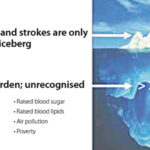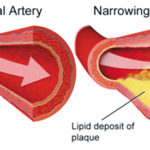Dr. Saleha Noorain
Cardiovascular disease (CVD) is the leading cause of death and disability globally, contributing to 1/3rd of all deaths and it continues to grow at an alarming rate with each passing year. Ischemic heart disease and stroke contribute to about 80% of all cardiovascular deaths.
As the magnitude of CVDs continue to accelerate, there is a pressing need for increased awareness and focused approaches to tackle this health hazard.
CVD’s include diseases of the heart and blood vessels throughout the body, including that of the brain (Stroke).
It is broadly classified into atherosclerosis and non-atherosclerotic cardiac diseases.
This article will discuss atherosclerotic Disease which includes:
i. Ischemic Heart Disease or Coronary Artery disease
ii. Cerebrovascular accidents (CVA) or commonly known as Stroke.
iii. Peripheral Vascular Disease “ affecting blood vessels apart from the heart and brain.
Atherosclerosis is a complex process in the walls of the blood vessels that develops over many years, beginning as early as the first decade of life. It can affect blood vessels throughout the body. It results in deposition of fatty material and cholesterol on the inner surface blood vessel, causing it to become narrow and irregular, resulting in obstruction to blood flow to the affected organ. These deposits or lesions are called as “plaques”. When such a plaque ruptures, it results in formation of blood clot within the blood vessel. This process in the blood vessels supplying the heart results in “Heart Attack”, while that affecting the brain causes “Stroke”.
What are the risk factors?
Modifiable risk factors, those which can be altered, include inadequate physical activity/sedentary lifestyle, smoking, unhealthy diet, obesity, high blood pressure, diabetes, and abnormal cholesterol levels. Non-modifiable risk factors those ehich cannot be altered, include male gender, advancing age, family history and ethnic background of the individual.
How do I know if I have a block in my blood vessel/artery?
Generally plaques causing less than 50% narrowing of the vessel do not cause any symptoms, unless they rupture and result in blood clot occluding the artery resulting in heart attack/ stroke, etc depending on the area affected.
However blockages causing more than 50% blockage interfere with the blood supply to the affected organ. If it involves the heart vessels, usual symptoms include chest pain on exertion, similarly if brain is affected it can cause reversible speech disturbances, weakness in the limbs, loss of sight, etc.
Prevention is better than cure!
A large percentage of CVDs can be prevented by reducing the modifiable or behavioral risk factors. There is enough evidence showing that quitting to smoke, weight loss, increased physical activity, adapting healthy diet reduces the risk for CVD by a significant proportion. 150 min of moderate physical activity per week has shown to reduce the risk of IHD by 30%.
Management:
It includes optimal management of underlying risk factors like diabetes, abnormal cholesterol levels and high blood pressure along with disease specific management.
Depending on the extent of disease involvement, medical, interventional and surgical options are available. Medical management includes prescribing certain medications which can control disease progression. If the disease is more advanced, patient may require an angiogram, which is an invasive test to see the extent of involvement and then depending on its result, further treatment is planned. This may include angioplasty or surgery.
Angioplasty is a minimally invasive, endovascular technique, performed mostly through the thigh or forearm by which the obstructive lesions in the blood vessels are widened using balloon catheters, followed by insertion of a stent most of the times to improve blood flow. For more complex or multiple lesions, generally surgery is advised, most commonly a bypass surgery.
(The Author is an interventional cardiologist. She can be reached at Primecare Hospital, MM Road, Frazer Town. Email: salehanoorai@gmail.com)



COMMENTS